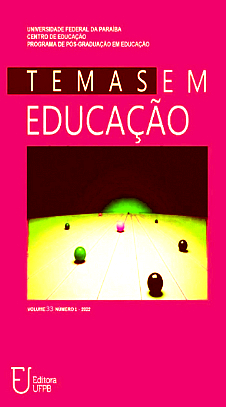INTEGRATIVE REVIEW ON PEDAGOGIC STRATEGIES FOR DEAF STUDENTS IN PHYSICAL EDUCATION CLASSES
DOI:
https://doi.org/10.22478/ufpb.2359-7003.2024v33n1.67712Keywords:
Pedagogical Practices. Deaf Student. Physical Education School.Abstract
In the wake of history, Physical Education became correlated with the misguided notion of the perfect body and performance in classes, resulting in the exclusion of educational principles. Students considered "incapable" did not have access to the knowledge addressed by this curricular component. Especially since the 1990s, Physical Education has continuously sought to distance itself from this exclusionary standard and has begun to offer studies dedicated to the creation of inclusive classes that align with students' reality, aiming for a pedagogical transformation of lessons. Thus, the aim of this study, through an integrative review, was to analyze the scientific production concerning pedagogical strategies for deaf students in Physical Education classes. Data were collected from the CAPES Periodicals Portal and Google Scholar databases, spanning from 2012 to 2022. Controlled descriptors were employed: Deaf Student or Deafness and "Physical Education"; Deaf Student or Deafness and Pedagogical Experience and "Physical Education"; Deaf Student or Deafness and School and "Physical Education". The final sample consisted of nine selected articles after analyzing titles, abstracts, and full texts. Accordingly, following a thorough analysis of the expressed content, the suggested and/or used pedagogical strategies by educators were selected and categorized into short, medium, and long-term approaches.
Downloads
References
BRASIL. Decreto 5.626 de 22 de dezembro de 2005. Regulamenta a Lei n o 10.436, de 24 de abril de 2002, que dispõe sobre a Língua Brasileira de Sinais - Libras, e o art. 18 da Lei no 10.098, de 19 de dezembro de 2000. Presidência da República, Brasília, 2005. Disponível em: https://www.planalto.gov.br/ccivil_03/_Ato2004-2006/2005/Decreto/D5626.htm. Acesso em: 15 abr. 2020.
BRASIL. Lei Federal 10.436 de 24 de abril de 2002. Dispõe sobre a Língua Brasileira de Sinais - Libras e dá outras providências. Presidência da República, Brasília, 2002. Disponível em: https://www.planalto.gov.br/ccivil_03/leis/2002/l10436.htm. Acesso em: 15 abr. 2020.
BRASIL. Lei Federal 14.191 de 03 de agosto de 2021. Altera a Lei nº 9.394, de 20 de dezembro de 1996 (Lei de Diretrizes e Bases da Educação Nacional), para dispor sobre a modalidade de educação bilíngue de surdos. Presidência da República, Brasília, 2021. Disponível em: https://www.planalto.gov.br/ccivil_03/_ato2019-2022/2021/lei/l14191.htm. Acesso em: 15 abr. 2020.
CASTRO, A. L. M. B. D. O desenvolvimento da criatividade e da autonomia na escola: o que nos dizem Piaget e Vygotsky. Revista psicopedagogia, [S.l.], v. 23, n. 70, p. 49-61, 2006.
DARIDO, S. C. Educação física na escola: conteúdos, suas dimensões e significados. In: UNIVERSIDADE ESTADUAL PAULISTA. Prograd. Caderno de formação: formação de professores didática geral. São Paulo: Cultura Acadêmica, v. 16, p. 51-75, 2012.
MENDES, K. D. S.; SILVEIRA, R. C. C. P; GALVÃO, C. M. Revisão Integrativa: Método de Pesquisa para a Incorporação de Evidências na Saúde e na Enfermagem. Texto Contexto – Enfermagem, [S.l.], v. 17, n. 4, p. 758-764, 2008. Disponível em: https://www.scielo.br/j/tce/a/XzFkq6tjWs4wHNqNjKJLkXQ/?lang=pt. Acesso em: 21 jan. 2022.
RAMOS, C. R. Tecnologia Assistiva para Surdos: Produtos, estratégias, recursos e serviços. RVCSD - Revista Virtual de Cultura Surda e Diversidade, [S.l.], n. 9, 2012. Disponível em: http://www.porsinal.pt/index.php?ps=artigos&idt=artc&cat=12&idart=173.
ROGALSKI, S. M. Histórico do Surgimento da Educação Especial. Revista de Educação do Ideau, [S.l.], v. 5, n. 12, p. 1-13, 2010. Disponível em: https://www.bage.ideau.com.br/wp-content/files_mf/02839f232c38b58c9b9915aae8e7a0d8168_1.pdf. Acesso em: 2 fev. 2022.
ROVIRA, C.; GUERRERO-SOLÉ, F.; CODINA, L. Received citations as a main SEO factor of Google Scholar results ranking. El profesional de la información, [S.l.], v. 27, n. 3, p. 559–569, 2018. Disponível em: https://revista.profesionaldelainformacion.com/index.php/EPI/article/view/epi.2018.may.09. Acesso em: 11 de nov. 2022.
SAVIANI, D. Pedagogia Histórico-Crítica: Primeiras Aproximações. 9ed. Campinas, Autores Associados, 2005.
SOARES, C. L. et al. Metodologia do Ensino da Educação Física. São Paulo: Cortez. 1992.
SOUZA, F. F; SILVA, D. N. H. O Corpo que brinca: Recursos simbólicos na brincadeira de crianças surdas. Psicologia em Estudo, Maringá, v. 15, n. 4, p. 705- 712, 2010. Disponível em: //www.scielo.br/j/pe/a/46Rsk4YzPTMWgzf7TbLDFKM/. Acesso em: 10 fev. 2022.
UNESCO. Declaração de Salamanca sobre princípios, política e práticas na área das necessidades educativas especiais. UNESCO, 1998. Disponível em: https://unesdoc.unesco.org/ark:/48223/pf0000139394 . Acesso em: 15 abr. 2020.
WHITE, B. J. From"deaf"to"Dear": Defining Deaf Culture, 1998. Disponível em: https://core.ac.uk/download/pdf/159608966.pdf.
WHO. (World Health Organization). Prevention of deafness andhearing loss. 2018. Disponível em: http://www.who.int/deafness/en/. Acesso em: 30 abr. 2022.
ZABOT, D.; ANDRADE, S.; MATOS, E. Game Design participativo com crianças surdas e com deficiência auditiva: uma experiência no ensino fundamental. In: Workshop sobre interação e pesquisa de usuários no desenvolvimento de jogos (WIPLAY), Vitória, 2019. Anais [...]. Porto Alegre: Sociedade Brasileira de Computação, 2019, p. 49-58.
Downloads
Published
How to Cite
Issue
Section
License
Copyright (c) 2024 Revista Temas em Educação

This work is licensed under a Creative Commons Attribution 4.0 International License.
Authors who publish in this journal agree to the following terms:
. Authors retain the copyright and grant the journal the right to first publication, with the work simultaneously licensed under the Licença Creative Commons Attribution that allows the sharing of the work with acknowledgment of authorship and initial publication in this magazine. . Authors are authorized to assume additional contracts separately, for non-exclusive distribution of the version of the work published in this journal (eg, publishing in institutional repository or as a book chapter), with acknowledgment of authorship and initial publication in this journal.
. Authors are permitted and encouraged to publish and distribute their work online (eg in institutional repositories or on their personal page) at any point before or during the editorial process, as this can generate productive changes, as well as increase impact and citation of the published work (See O Efeito do Acesso Livre).



















